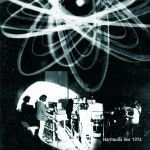
Harmonia Live 1974
(Groenland)
Harmonia were something of a krautrock supergroup, encompassing the two guys who were Cluster, Hans-Joachim Roedelius and Dieter Moebius, and Michael Rother, a guitarist for NEU! Harmonia live 1974 captures them relatively early in their brief career, lasting a few albums in the mid-70s before Rother struck out on a solo path. It does not sound at all like a stereotypical live album. Crowd noise is absent. For all I know, "crowd" may have been almost absent for this show at Penny Station in Griessem, Germany. There are no vocals, and the hour long recording consists of five long, mid-tempo instrumentals heavy on texture and light on conventional melody or structure, initially difficult to differentiate without the pauses between. What instrumentals they are.
Moebius and Rother are both credited with electronic percussion, creating passive rhythms that chug along a soothing mechanical lock-step, gently warping and receding sonically, the white noise of machines mutating in the mind. Between the three of them, all of them playing some keys, be they synthesizer, electric organ, or piano, layers of repetitive phases build, change and interact in tantalizing yet ignorable ways, drifting in and out, blurring the boundaries between each other. A hypnotic element does not make itself known until well after having its effect, submerged and subliminal uses of techniques DJs would use years later. Rother's guitar avoids riffage, appearing when it does to repeat and undulate or coast, stripping away all gloss through effects.
Years before the idea of post-rock, Harmonia are a fine example of how groups in 70s Germany took some known elements of pop, some elements of technology, and made work that completely questioned or subverted the aims and structure of the music. It extends the space that crept into rock with the intense experimentation of psychedelia, but refuses to offer the anchor of sharp dynamics, stubbornly and leisurely remaining in the space without release or explosion, incorporating elements in and out discreetly. This is not insistent music, but it sounds both timeless and modern, evoking always noises rockers have since been lathering onto their tunes or working into interludes to indicate "texture."
It is no surprise, then, that Brian Eno, who later collaborated with both Harmonia and Cluster, was smitten. Harmonia is a perfect illustration of the aims of ambient music, which Eno would go on to "invent" a few years later. That is Harmonia's music is equally suitable as purely unobtrusive background hum, and something to listen to intently. It takes multiple listens to begin picking apart the variety of hypnotic elements, where they slowly change and dissapear, and how they interact against one another. More than a collection of names and associations to drop, Harmonia succeeds in making bottomless, subjective music, passive enough that it dares you to engage, active enough that its repitions do not become boring, and long enough to depart and return at one's pleasure.
13 September, 2007 - 16:38 — George Booker